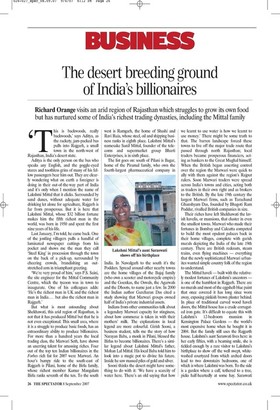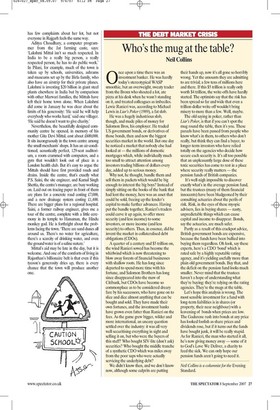The desert breeding ground of India's billionaires
Richard Orange visits an arid region of Rajasthan which struggles to grow its own food but has nurtured some of India's richest trading dynasties, including the Mittal family his is backwoods, really backwoods,' says Aditya, as the rackety, jam-packed bus pulls into Rajgarh, a small town in the north-west of Rajasthan, India's desert state.
Aditya is the only person on the bus who speaks any English, and the goggle-eyed stares and toothless grins of many of his fellow passengers bear him out. They are clearly wondering what on earth a foreigner is doing in their out-of-the-way part of India and it's only when I mention the name of Lakshmi Mittal that it clicks. Surrounded by sand dunes, without adequate water for drinking let alone for agriculture, Rajgarh is far from prosperous. But it is here that Lakshmi Mittal, whose $32 billion fortune makes him the fifth richest man in the world, was born in 1950 and spent the first nine years of his life.
Last January, I'm told, he came back. One of the jostling villagers pulls a handful of laminated newspaper cuttings from his pocket and shows me the man they call 'Steel King' in procession through the town on the back of a pick-up, surrounded by cheering crowds, brandishing an outstretched arm in triumphant greeting.
'We're very proud of him,' says P.S. Saini, the site engineer for the Mittal Community Centre, which the tycoon was in town to inaugurate. One of his colleagues adds: 'He's the richest man in UK and the richest man in India... but also the richest man in Rajgarh.'
But what is most astounding about Shekhawati, this arid region of Rajasthan, is not that it has produced Mittal but that he is not even exceptional. This small area, where it is a struggle to produce basic foods, has an extraordinary ability to produce billionaires. For more than a hundred years the local trading class, the Marwari Seth, have shown an unerring talent for amassing riches. Four out of the top ten Indian billionaires in the Forbes rich list for 2007 were Marwari. An hour's bumpy ride to the south-east of Rajgarh is Pilani, home of the Birla family, whose richest member Kumar Mangalam Birla ranks seventh of the ten. To the south west is Ramgarh, the home of Shashi and Ravi Ruia, whose steel, oil and shipping business ranks in eighth place. Lakshmi Mittal's namesake Sunil Mittal, founder of the telecoms and supermarket group Bharti Enterprises, is in sixth place.
The list goes on: south of Pilani is Bagar, home of the Piramal family, who own the fourth-largest pharmaceutical company in India. In Nawalgarh to the south it's the Poddars. Spread around other nearby towns are the home villages of the Bajaj family (who own a scooter and motorcycle empire) and the Goenkas, the Oswals, the Agarwals and the Dhoots, to name just a few. In 2000 the Indian author Gurcharan Das cited a study showing that Marwari groups owned half of India's private industrial assets.
Indians from other communities talk about a legendary Marwari capacity for stinginess, about how commerce is taken in with their mothers' milk. The explanations in local legend are more colourful. Girish Sooni, a business student, tells me the story of how Narayan Baba, a monk in Pilani, blessed the Birlas to become billionaires. There's a similar legend about Lakshmi Mittal's father, Mohan Lal Mittal. His local Baba told him to look into a magic pot to divine his future. Inside he saw massed piles of gold and silver.
Sooni thinks the desert might have something to do with it: 'We have a scarcity of water here. There's an old saying that how we learnt to use water is how we learnt to use money.' There might be some truth to that. The barren landscape forced these towns to live off the major trade route that passed through north Rajasthan; local traders became prosperous financiers, acting as bankers to the Great Mughal himself. When the British began asserting control over the region the Marwari were quick to ally with them against the region's Rajput rulers. Soon Marwari traders were spread across India's towns and cities, acting both as traders in their own right and as brokers to the British. By the late 19th century the largest Marwari firms, such as Tarachand Ghanshyam Das, founded by Bhagoti Ram Poddar, rivalled British companies in size.
Their riches have left Shekhawati the lavish havelis, or mansions, that cluster in even the smallest towns. Marwari who made their fortunes in Bombay and Calcutta competed to build the most opulent palaces back in their home villages, complete with garish murals depicting the India of the late 19th century. There are British redcoats, steam trains, even flying machines — everything that the newly sophisticated Marwari urbanites wanted simple country folk of the region to understand.
The Mittal haveli — built with the relatively modest fortunes of Lakshmi's ancestors — is one of the humblest in Rajgarh. There are no murals and most of the eggshell-blue paint that once covered it has long since worn away, exposing pinkish brown plaster behind. In place of traditional carved wood haveli doors, the Mittal house has a crude corrugated iron gate. It's difficult to equate this with Lakshmi's 12-bedroom mansion in Kensington Palace Gardens — the world's most expensive home when he bought it in 2004. But the family still uses the Rajgarth house. Lakshmi's aunt Saraswati lives here: in her early fifties, with a beaming smile, she is tickled enough by a rare visitor to Lakshmi's birthplace to show off the well swept, whitewashed courtyard from which arched doors lead to two downstairs bedrooms, one of which is where Lakshmi was born. To the side is a garden where a calf, tethered to a tree, picks half-heartedly at some hay. Saraswati has few complaints about her lot, but not everyone in Rajgarh feels the same way.
Aditya Choudhary, a computer programmer from the Jat farming caste, says: `Lakshmi Mittal isn't so much respected. In India to be a really big person, a really respected person, he has to do public work.' In Pilani, for example, much of the town is taken up by schools, universities, ashrams and museums set up by the Birla family, who also have an airstrip for their private planes. Lakshmi is investing $20 billion in giant steel plants elsewhere in India but by comparison with other Marwari families, the Mittals have left their home town alone. When Lakshmi did come in January he was clear about the limits of his generosity: 'He said he will help everybody who works hard,' said one villager. 'He said he doesn't want to give charity.'
Nevertheless, the beautifully designed community centre he opened, in memory of his mother Gita Devi Mittal, cost about £600,000. It sits incongruously in the town centre among the small merchants' shops. It has an air-conditioned, acoustically perfect, 129-seat auditorium, a room crammed with computers, and a gym that wouldn't look out of place in a London health club. But it's easy to argue the Minals should have first provided roads and drains. Inside the centre, that's exactly what PS Saini, the site engineer, and Kamal Singh Shettia, the centre's manager, are busy working on. Laid out on tracing paper in front of them are plans for a concrete road costing 0,000, and a new drainage system costing £1,400. There are bigger plans for a regional hospital. Saini, a former railway engineer, gives me a tour of the centre, complete with a little ceremony in its temple to Hanuman, the Hindu monkey god. He is forthright about the problems facing the town. 'There are sand dunes all around us. There's no water for agriculture, there's a scarcity of drinking water, and even the ground water is of a saline nature.'
Mittal's aid may be late in the day, but it is welcome. And one of the comforts of living in Rajasthan's billionaire belt is that even if this tycoon's generosity dries up, there is every chance that the town will produce another one.




































































 Previous page
Previous page